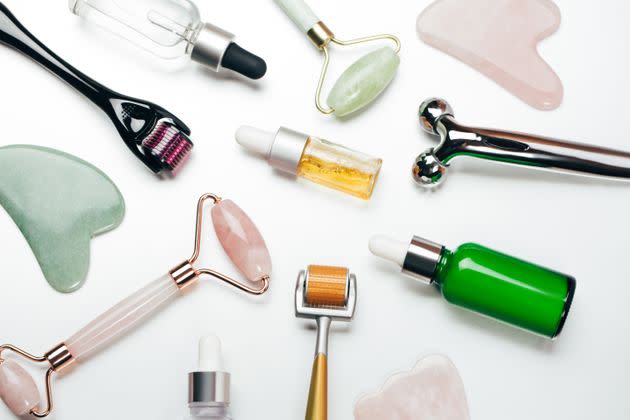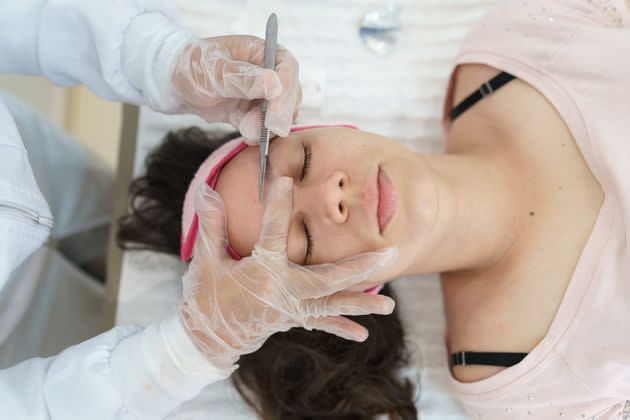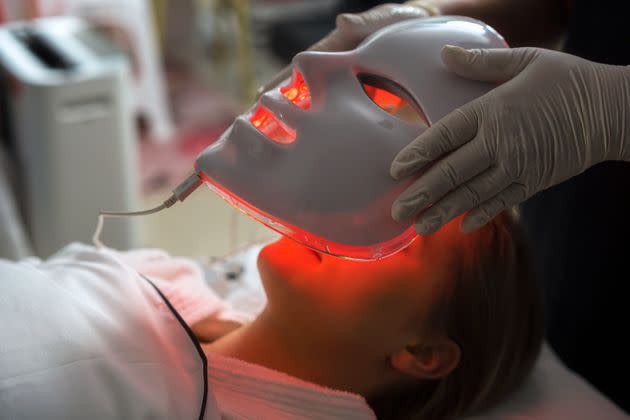At-Home Skin Care Devices Dermatologists REALLY Need You To Stop Using

After watching hours of your favorite skin care influencers “get unready with me” or reading the latest listicle on your preferred beauty site, it can be tempting to order a new gadget promising to give you ageless, glowy, blemish-free skin. And when many of these devices claim to offer the same results you’d see in a professional’s office for a fraction of the price, what do you have to lose?
However, taking matters into your own hands (particularly with tools that the Food and Drug Administration has not reviewed for safety) can severely damage your skin.
Skin care professionals rely on their years of training, experience and expertise to decide which procedures are suitable for their patients, considering things like surgical and vaccination history, pregnancy, history of scarring and hyperpigmentation, current medications and environmental factors. If, for example, you’re planning a fun-in-the-sun beach vacation, your dermatologist might suggest skipping the chemical peel.
HuffPost spoke to four board-certified dermatologists about eight popular skin care devices that should probably be retired from your shelfie.
5 To Absolutely Avoid
1. Microneedle Dermarollers
Microneedle dermarollers use hundreds of tiny needles to puncture the skin, stimulating collagen production and boosting ingredient absorption with serums. When done properly in a professional’s office, microneedling is shown to help fade hyperpigmentation and acne scars. But despite the numerous beauty stores that sell at-home microneedle devices, these tools can cause far bigger problems for your skin than a few fine lines.
“There are so many things that can go wrong with at-home microneedling,” said Dr. Angela Casey, an Ohio-based dermatologist. “The at-home devices are never sterilized properly, and then the individual is puncturing their skin with the needles. This can introduce infection into the skin.”
And it’s not only the cleanliness of the tool that should concern users. “If a microneedling device is rolled or applied over an area of makeup, that makeup can get deep enough into the skin to cause a traumatic tattoo,” Casey warned.
Amateur microneedling also lacks the precision of instruments used in skin care professionals’ offices.
“At-home devices are limited in how much of a benefit they can deliver and come with risks of injuring the skin, which can lead to irritation, scarring or hyperpigmentation,” said Dr. Marisa Garshick, a New York-based dermatologist. “Since often the risks outweigh the benefits, it is preferred to do this procedure in an in-office setting.”
2. Pore Vacuums And Cupping Devices
Pore vacuums and cupping tools both claim to improve the skin with suction. Companies say that cupping devices create a glowy complexion by suctioning dirt and debris right out of the pores.
“While pore vacuums may improve the appearance of the pores by temporarily removing some of the buildup ... it will not prevent the blackheads from recurring,” Garshick said.
“Like nose strips, it helps remove blackheads that are already loosened,” said Dr. Elaine Kung, a New York-based dermatologist. “Pore vacuums’ suctioning can cause bruising, broken blood vessels and microtears in the skin.”
And despite brands stating that cupping tools can improve blood circulation, relieve tension and increase collagen, Kung noted that no scientific evidence supports these claims.
“Skin cupping temporarily causes tissue swelling, so it makes the skin look plumper,” Kung said. However, the suction caused by cupping can “also cause bruising and broken blood vessels.”
3. Chemical Peels
Hundreds of videos across social media feature users who found out the hard way that their skin was not ready for an infamous AHA/BHA peeling solution from beauty brand The Ordinary. However, that product pales in comparison to other chemical peels that users can easily purchase online — some of which offer concentrations as strong as 100%.
“One must have a thorough knowledge of the skin condition being treated and the type of chemical peel that is selected,” Casey said. “Chemical peels for acne are very different from those for hyperpigmentation, which are different from those for skin laxity.”
Additionally, some chemical peels are not as simple to use as your typical skin care product.
“Many peeling agents need to be neutralized, and if not properly neutralized, they can burn and damage the skin,” Casey said.
She also warned that for anyone currently using retinol products (which cause the outermost layer of the skin to become thinner), a chemical peel can penetrate the skin more deeply, leading to sensitivity and irritation. Additionally, hyperpigmentation and severe burns can occur if the person spends time in the sun.
“There are too many variables to consider with at-home chemical peels to allow them to be safe,” Casey said.

4. Dermaplaning And Microdermabrasion Tools
Dermaplaning uses a razorlike device to shave the top layer of the skin. Similarly, microdermabrasion uses aluminum oxide crystals to physically exfoliate dead cells from the top layer. With a skilled skin care professional, both procedures can reduce the appearance of fine lines, dullness, hyperpigmentation and acne scars. But in the hands of the average consumer, the results can be less than stellar.
Dr. Jeffrey Hsu, a Chicago-based dermatologist, warned that microdermabrasion devices for home use do not have the precise control settings found on dermatologists’ tools. He said that home users “are also not trained on what settings to use on certain skin types and conditions.”
“The skin changes conditions with lifestyle and weather. It is not just whether you have dry skin or eczema,” he said. “So not being able to recognize the changes in the skin and potentially using the wrong settings can result in over-exfoliating the skin.” Over-exfoliated skin can lead to redness, irritation and increased sensitivity, and it can damage the skin barrier.
Though cheap and easy-to-use dermaplaners, or “facial razors,” are marketed to consumers as a way to remove unwanted facial hair while also exfoliating, dermaplaning is not as simple as typical shaving.
“Even licensed aestheticians and skin care experts undergo specific training for this procedure. It can be very difficult to get the right angle for treatment that is safe and effective,” Casey said.
“People risk nicking, cutting or infecting themselves with dermaplaning,” Kung said. “I would suggest trading the blade for a weekly exfoliating cleanser with AHA or BHA.”
5. Plasma And Hyaluron Pens
Hyaluron and plasma pens promise customers the freedom to perform their own skin care procedures for less than the cost of a dermatologist visit. However, given the risks, your money is better spent on seeing a professional.
Hyaluron pens, also known as “needleless filler” devices, use high-pressure air to force hyaluronic acid into the skin. While a less invasive method of getting fillers may seem safer, the risks far outweigh the benefits.
“If FDA-regulated fillers done by medical professionals can carry a chance of complications in patients, can you imagine a procedure like this done at home?” Hsu said. “Depending on where these so-called fillers are placed, it can cause permanent blindness, face paralysis, etc.”
“The FDA recently issued a warning against using these devices for at-home use due to safety concerns,” Garshick said. According to the agency’s 2021 message, needle-free filler devices are not even recommended for use when administered by a skin care professional.
Hsu said he has come across multiple medical spas offering needle-free injections as an alternative to lip fillers.
“This is one of the most dangerous services I have seen,” he said. “The material sold for these pens is not produced by actual pharmaceutical companies and has not been through an actual sterilization process. The processes [for injectable fillers] are heavily regulated for pharmaceutical companies by the FDA. If something that is not sterile is put under the skin, we can be looking at tissue necrosis (deadening of tissue).”
Companies claim plasma pens can treat a wide range of skin imperfections by discharging electrostatic energy to remove skin tags, moles, warts, age spots, fine lines and more — essentially burning them off.
“Any device that produces enough heat that can remove skin can also severely scar or permanently pigment the skin if not used properly,” Hsu said. “Additionally, there are certain skin conditions or skin types that should not use heat to treat lesions of any sort on the skin.”
Skipping your dermatologist appointment to take matters into your own hands could turn deadly.
“With any lesion removal, there is no way of telling yourself if you are removing something that is benign or malignant,” Hsu said. “As dermatologists, we have gone through medical training to spot something suspicious. Even then, we still require biopsy confirmation. Removing something potentially malignant can mean delaying the treatment of skin cancer, which is fatal.”
3 To Use With Caution
1. Facial Cleansing Brushes
Similar to an electric toothbrush, facial cleansing brushes use sonic power or rotating brushes to deeply cleanse the skin while providing physical exfoliation. Bristles on these brushes can be made from materials like nylon or silicone. However, such “deep cleaning” devices can have adverse effects.
“Some brushes’ bristles are quite hard and abrasive, which is too much for the skin. Overusing it (i.e., through daily use) can compromise the skin,” Hsu said.
Furthermore, devices claiming to give you a “deeper cleanse” could potentially introduce bacteria to your skin.
“Just because it is a cleansing device, it doesn’t mean the device itself is clean,” Hsu said. “The bristles are hard to sanitize and will harbor bacteria over time. Imagine compromising the skin, plus infusing it with bacteria at the same time. That is a horror waiting to happen.”
In recent years, many companies have released facial cleansing brushes with silicone heads as a gentler option.
“Too much of anything is not good, so I won’t say that silicone facial cleansing brushes are bad and that consumers need to stay away from purchasing them,” Hsu said. “However, customers must follow the manufacturer’s direction of use.”
2. Gua Sha Tools And Skin Rollers
Gua sha tools and skin rollers, commonly made of semiprecious stones, look gorgeous in influencers’ aesthetically focused videos. Skin rollers (also known as facial rollers) are small, smooth, hand-held tools that massage the face to provide better circulation and aid in lymphatic drainage. Gua sha promises similar effects via a different method. Based on traditional Chinese medicine techniques, gua sha uses a stone tool that’s small and flat to scrape the skin.
“The friction and rubbing will cause temporary tissue swelling, making someone’s face look plump and rosy,” Kung said. “There is no scientific evidence that gua sha actually improves circulation or collagen production. Gua sha can cause bruising and broken blood vessels, which can worsen rosacea.”
Casey said skin rollers can have ill effects as well.
“An understanding of facial anatomy and lymphatic drainage is necessary to properly and optimally use these devices,” she said. “I have seen rosacea patients over the years who have actually worsened their rosacea from aggressive use of skin rollers or gua sha tools. ... It’s a major setback that requires lasers and topical therapies to reverse.”

3. Light-Based Devices
From small pen-sized tools to face masks resembling something out of a sci-fi space opera, light therapy devices claim to improve a range of skin care woes, including fine lines and acne.
“Blue light has been shown to be antimicrobial and red light is anti-inflammatory,” Casey said. “However, caution and precision must be exercised when using these devices. Blue light has been shown to cause hyperpigmentation and can exacerbate conditions such as melasma.”
And LED devices can interfere with one of the most important processes to create healthy, glowy skin: your sleep.
“Blue light can impact our circadian rhythms and melatonin production,” Casey said. “Maintaining optimal circadian rhythms and getting quality sleep are fundamental to achieving our healthiest skin.”